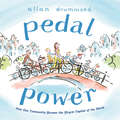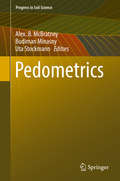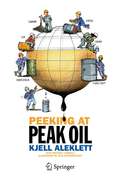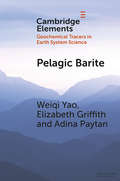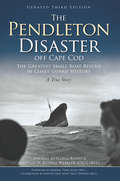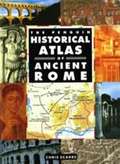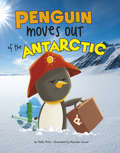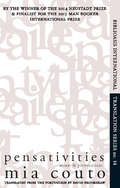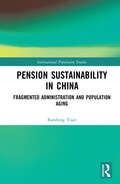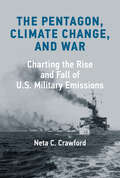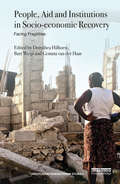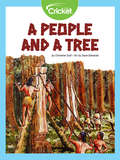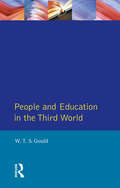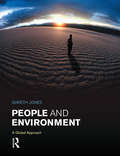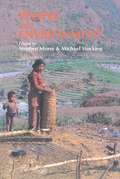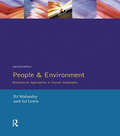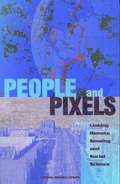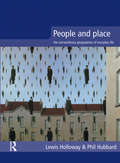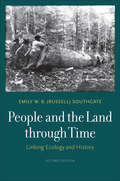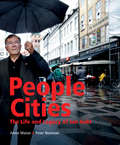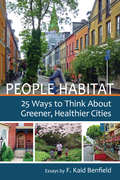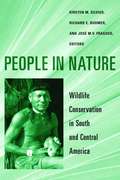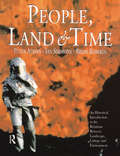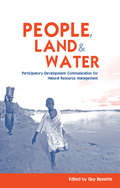- Table View
- List View
Pedal Power: How One Community Became the Bicycle Capital of the World (Green Power)
by Allan DrummondCycling rules the road in Amsterdam today, but that wasn't always the case. In the 1970's, Amsterdam was so crowded with vehicles that bicyclists could hardly move, but moms and kids relied on their bicycles to get around the city. PEDAL POWER is the story of the people who led protests against the unsafe streets and took over a vehicles-only tunnel on their bikes, showing what a little pedal power could do! Author and illustrator Allan Drummond returns with the story of the people that paved the way for safe biking around the world.
Pedometrics (Progress In Soil Science Ser.)
by Uta Stockmann Budiman Minasny Alex. B. McBratneyThis book presents the basic concepts of quantitative soil science and, within this framework, it seeks to construct a new body of knowledge. There is a growing need for quantitative approach in soil science, which arises from a general demand for improved economic production and environmental management. Pedometrics can be defined as the development and application of statistical and mathematical methods applicable to data analysis problems in soil science. This book shows how pedometrics can address key soil-related questions from a quantitative point of view. It addresses four main areas which are akin to the problems of conventional pedology: (i) Understanding the pattern of soil distribution in character space – soil classification, (ii) Understanding soil spatial and temporal variation, (iii) Evaluating the utility and quality of soil and ultimately, (iv) Understanding the genesis of soil. This is the first book that address these problems in a coherent quantitate approach.
Peeking at Peak Oil
by Michael Lardelli Olle Qvennerstedt Kjell AleklettThe term "Peak Oil" was born in January 2001 when Colin Campbell formed the Association for the Study of Peak Oil & Gas (ASPO). Now, Peak Oil is used thousands of times a day by journalists, politicians, industry leaders, economists, scientists and countless others around the globe. Peak Oil is not the end of oil but it tells us the end is in sight. Anyone interested in food production, economic growth, climate change or global security needs to understand this new reality. In Peeking at Peak Oil Professor Kjell Aleklett, President of ASPO International and head of the world's leading research group on Peak Oil, describes the decade-long journey of Peak Oil from extremist fringe theory to today's accepted fact: Global oil production is entering terminal decline. He explains everything you need to know about Peak Oil and its world-changing consequences from an insider's perspective. In simple steps, Kjell tells us how oil is formed, discovered and produced. He uses science to reveal the errors and deceit of national and international oil authorities, companies and governments too terrified to admit the truth. He describes his personal involvement in the intrigues of the past decade. What happens when a handful of giant oil fields containing two thirds of our planet's oil become depleted? Will major oil consumers such as the EU and US face rationing within a decade? Will oil producing nations conserve their own oil when they realize that no one can export oil to them in the future? Does Peak Oil mean Peak Economic Growth? If you want to know the real story about energy today and what the future has in store, then you need to be "Peeking at Peak Oil".
Pelagic Barite: Tracer of Ocean Productivity and a Recorder of Isotopic Compositions of Seawater S, O, Sr, Ca and Ba (Elements in Geochemical Tracers in Earth System Science)
by Weiqi Yao Elizabeth Griffith Adina PaytanReconstruction of ocean paleoproductivity and paleochemistry is paramount to understanding global biogeochemical cycles such as the carbon, oxygen and sulfur cycles and the responses of these cycles to changes in climate and tectonics. Paleo-reconstruction involves the application of various tracers that record seawater compositions, which in turn may be used to infer oceanic processes. Several important tracers are incorporated into pelagic barite, an authigenic mineral that forms in the water column. Here we summarize the utility of pelagic barite for the reconstruction of export production and as a recorder of seawater S, O, Sr, Ca and Ba.
The Pendleton Disaster Off Cape Cod: The Greatest Small Boat Rescue in Coast Guard History, A True Story (Disaster)
by Theresa Mitchell Barbo Captain W. Russell WebsterA first-hand account and fascinating new details of the 1952 rescue of the SS Pendleton, the true story behind the film The Finest Hours.On February 18, 1952, off the coast of Cape Cod, a fierce nor’easter snapped in half two 503-foot oil tankers, the Pendleton and the Fort Mercer. Human grace and grit, leadership and endurance prevail as Theresa Mitchell Barbo and Captain W. Russell Webster (Ret.) recount the historic, heroic rescue of thirty-two merchant mariners from the sinking Pendleton by four young Coast Guardsmen aboard the 36-foot motor lifeboat CG 36500. A foreword by former Commandant Admiral Thad Allen (Ret.) and an essay by Master Chief John “Jack” Downey (Ret.), a veteran of thousands of modern-day small boat rescues, round out the special third edition of this classic work on Coast Guard history.
The Penguin Historical Atlas of Ancient Rome
by Chris ScarreThe Penguin Historical Atlas of Ancient Rome is an introduction to the Roman Empire based on maps.
Penguin Moves Out of the Antarctic (Habitat Hunter)
by Nikki PottsPenguin is bored with its habitat! Follow Penguin as it tries out different places to live. Which habitat will make the best home for Penguin?
The Penguin of Ilha Grande: From Animal Rescue to Extraordinary Friendship
by Shannon EarleA man rescues a penguin off the coast of Brazil and finds a lifelong connection in this delightful true story about the power of friendship.When an oil-covered penguin washes up in Brazil, Seu João saves the penguin's life. Soon man and penguin are friends, and Dindim the penguin won't return to the wild. At last Dindim swims away, only to return four months later! For seven years, Dindim the penguin lived with Seu João in Brazil for eight months a year, disappearing for four months after his annual molting. Readers will enjoy discovering the wildlife of Brazil while learning about the impacts of oil spills and the importance of conservation. This inspiring, true account of real and unusual friendships is sure to win the hearts of nature and animal lovers alike.
Pensativities
by Mia Couto David Brookshaw"One of the greatest living writers in the Portuguese language."--Philip Graham, The Millions"Subtle and elegant."--The Wall Street Journal"At once deadpan and beguiling."--The Times Literary Supplement"To understand what makes António 'Mia' Emílio Leite Couto special--even extraordinary--we have to loosen our grip on the binary that distinguishes between 'the West' and 'Africa.' Couto is 'white' without not being African, and as an 'African' writer he's one of the most important figures in a global Lusophone literature that stretches across three continents."--The New InquiryWhat would Barack Obama's 2004 campaign have looked like if it unfolded in an African nation? What does it mean to be an African writer today? How do writers and poets from all continents teach us to cross the sertão, the savannah, the barren places where we're forced to walk within ourselves? Bringing together the best pieces from his previously untranslated nonfiction collections, alongside new material presented here for the first time in any language, Pensativities offers English readers a taste of Mia Couto as essayist, lecturer, and journalist--with essays on cosmopolitanism, poverty, culture gaps, conservation, and more.Mia Couto, an environmental biologist from Mozambique, is the author of twenty five books of fiction, nonfiction, and poetry. His work has been translated into twenty languages worldwide. In 2007 he was the first African author to win the Latin Union Award for Romance Languages, in 2013 he was awarded the 100,000 Camões Prize for Literature, and in 2014 he received World Literature Today's $50,000 Neustadt Prize for Literature.
Pension Sustainability in China: Fragmented Administration and Population Aging (International Population Studies)
by Randong YuanPension Sustainability in China: Fragmented Administration and Population Aging aims to investigate the impact of fragmentation and population ageing on pension sustainability in China. The book demonstrates how pension sustainability is compromised by various adverse effects produced by fragmentation, such as the moral hazard caused by the disarticulated intergovernmental fiscal responsibility. An overlapping generations (OLG) model is updated with the latest demographic data and is used to assess the impact of population ageing on pension sustainability. The book considers whether adjustment in retirement age can ensure long-term financial sustainability. It explores how, compared to the population ageing, the issues stemming from the fragmentation pose a more insidious threat to pension sustainability in China.
The Pentagon, Climate Change, and War: Charting the Rise and Fall of U.S. Military Emissions
by Neta C. CrawfordHow the Pentagon became the world&’s largest single greenhouse gas emitter and why it&’s not too late to break the link between national security and fossil fuel consumption.The military has for years (unlike many politicians) acknowledged that climate change is real, creating conditions so extreme that some military officials fear future climate wars. At the same time, the U.S. Department of Defense—military forces and DOD agencies—is the largest single energy consumer in the United States and the world&’s largest institutional greenhouse gas emitter. In this eye-opening book, Neta Crawford traces the U.S. military&’s growing consumption of energy and calls for a reconceptualization of foreign policy and military doctrine. Only such a rethinking, she argues, will break the link between national security and fossil fuels. The Pentagon, Climate Change, and War shows how the U.S. economy and military together have created a deep and long-term cycle of economic growth, fossil fuel use, and dependency. This cycle has shaped U.S. military doctrine and, over the past fifty years, has driven the mission to protect access to Persian Gulf oil. Crawford shows that even as the U.S. military acknowledged and adapted to human-caused climate change, it resisted reporting its own greenhouse gas emissions. Examining the idea of climate change as a &“threat multiplier&” in national security, she argues that the United States faces more risk from climate change than from lost access to Persian Gulf oil—or from most military conflicts. The most effective way to cut military emissions, Crawford suggests provocatively, is to rethink U.S. grand strategy, which would enable the United States to reduce the size and operations of the military.
People, Aid and Institutions in Socio-economic Recovery: Facing Fragilities (Routledge Humanitarian Studies)
by Dorothea Hilhorst Bart Weijs Gemma Van Der HaarAn estimated 2 billion people live in countries affected by fragility, conflict and violence. Extreme poverty is increasingly concentrated in these areas, and governments and international agencies seek avenues to enable socio-economic recovery and to support people as they try to rebuild their lives and livelihoods. People, Aid and Institutions in Socio-economic Recovery: Facing Fragilities provides an in-depth understanding of people’s strategies in the face of conflict and disaster-related fragility and examines how policies and aid interventions enable their socio-economic recovery – or fail to do so. Through field-based research, the book captures the complex and unfolding realities on the ground, exploring the interfaces between economic, social and institutional change. This provides a rich and unique vantage point from which to reflect on the impact of recovery policies. The book provides a set of cross-cutting findings that aim to inform policy and practice. The detailed case studies of the book lay bare key dynamics of recovery. Set against the findings from two chapters that review the literature, the cases provide evidence-based lessons for socio-economic recovery. The chapters combine qualitative and quantitative methodologies and form a valuable resource to researchers and postgraduate students of disaster management, conflict, humanitarian aid and social reconstruction, and development management.
A People and a Tree
by Christine GrafNative American tribes from the Northwest Coast learned to use the wood of cedar trees for many of their daily needs. Tribes used recycling to conserve resources hundreds of years ago. Pounding bark until it was fluffy to make diapers and with special thin branches called withes, cedar trees were soaked and used to make rope. What special technique did tribes use to take down big cedar trees?
People and Education in the Third World (Longman Development Studies)
by W. T. GouldFirst published in 1993. Routledge is an imprint of Taylor & Francis, an informa company.
People and Environment: A Global Approach
by Gareth JonesPeople and Physical Environment, A Global Approach provides an introduction to the main areas of environmental concern for geographers, environmental scientists and planners at the beginning of the twenty-first century. These include:Pollution of the atmosphere and its impact on our climate; The exploitation of the oceans; Management and supply of fresh water; Degradation of the land, and Biodiversity, and the need to maintain genetic diversity.The book argues that our knowledge and understanding of the environment is now so great that we can predict with considerable accuracy where the skills of science and technology need to be focussed in order to prevent severe environmental damage from occurring. Achieving successful management of the environment has become dependent upon active participation of a society prepared to pay for a high quality of life and the willingness of our elected politicians to legislate and enforce the very highest standards of environmental management. This book will be essential reading for students of geography, environmental studies/science and land use planners and will also contribute valuable information for climatology, biogeography, hydrology, land economy and forestry students.
People And Environment: Development For The Future
by Stephen Morse Michael StockingFirst published in 1995. Routledge is an imprint of Taylor & Francis, an informa company.
People and Environment: Behavioural Approaches in Human Geography
by D. J. Walmsley G. J. LewisFirst published in 1994. Routledge is an imprint of Taylor & Francis, an informa company.
PEOPLE and PIXELS: Linking Remote Sensing and Social Science
by Committee on the Human Dimensions of Global ChangeSpace-based sensors are giving us an ever-closer and more comprehensive look at the earth's surface; they also have the potential to tell us about human activity. This volume examines the possibilities for using remote sensing technology to improve understanding of social processes and human-environment interactions. Examples include deforestation and regrowth in Brazil, population-environment interactions in Thailand, ancient and modern rural development in Guatemala, and urbanization in the United States, as well as early warnings of famine and disease outbreaks. The book also provides information on current sources of remotely sensed data and metadata and discusses what is involved in establishing effective collaborative efforts between scientists working with remote sensing technology and those working on social and environmental issues.
People and Place: The Extraordinary Geographies of Everyday Life
by Lewis Holloway Phil HubbardAn innovative introduction to Human Geography, exploring different ways of studying the relationships between people and place, and putting people at the centre of human geography. The book covers behavioural, humanistic and cultural traditions, showing how these can lead to a nuanced understanding of how we relate to our surroundings on a day-to-day basis. The authors also explore how human geography is currently influenced by 'postmodern' ideas stressing difference and diversity. While taking the importance of these different approaches seriously as ways of thinking about the role of place in peoples' everyday lives, the book also tries to encapsulate what has been so vibrant and exciting about human geography over the last couple of decades. By using examples to which students can relate - such as how they imagine and represent their home, the way they avoid certain spaces, how they move through retail spaces, where they choose to go to university, how they use the Internet, how they represent other nations and so on - the authors show how geography shapes everyday life in a manner that is seemingly mundane yet profoundly important.
People and the Land through Time: Linking Ecology and History, Second Edition
by Emily W. SouthgateA revised and updated edition of a classic book that defines the field of historical ecologyPeople and the Land through Time, first published in 1997, remains the only introduction to the field of historical ecology from the perspective of ecology and ecosystem processes. Widely praised for its emphasis on the integration of historical information into scientific analyses, it will be useful to an interdisciplinary audience of students and professionals in ecology, conservation, history, archaeology, geography, and anthropology. This up-to-date second edition addresses current issues in historical ecology such as the proposed geological epoch, the Anthropocene; historical species dispersal and extinction; the impacts of past climatic fluctuations; and trends in sustainability and conservation.
People Cities: The Life and Legacy of Jan Gehl
by Peter Newman Annie Matan"A good city is like a good party--you stay for longer than you plan," says Danish architect Jan Gehl. He believes that good architecture is not about form, but about the interaction between form and life. Over the last 50 years, Gehl has changed the way that we think about architecture and city planning--moving from the Modernist separation of uses to a human-scale approach inviting people to use their cities.At a time when growing numbers are populating cities, planning urban spaces to be humane, safe, and open to all is ever-more critical. With the help of Jan Gehl, we can all become advocates for human-scale design.Jan's research, theories, and strategies have been helping cities to reclaim their public space and recover from the great post-WWII car invasion. His work has influenced public space improvements in over 50 global cities, including New York, London, Moscow, Copenhagen, Melbourne, Sydney, and the authors' hometown of Perth.While much has been written by Jan Gehl about his approach, and by others about his influence, this book tells the inside story of how he learned to study urban spaces and implement his people-centered approach.People Cities discusses the work, theory, life, and influence of Jan Gehl from the perspective of those who have worked with him across the globe. Authors Matan and Newman celebrate Jan's role in changing the urban planning paradigm from an abstract, ideological modernism to a people-focused movement. It is organized around the creation of that movement, using key periods in Jan's working life as a structure.People Cities will inspire anyone who wants to create vibrant, human-scale cities and understand the ideas and work of an architect who has most influenced how we should and can design cities for people.
People Habitat: 25 Ways to Think About Greener, Healthier Cities
by F. Kaid BenfieldWith over 80 percent of Americans now living in cities and suburbs, getting our communities right has never been more important, more complicated, or more fascinating. Longtime sustainability leader Kaid Benfield shares 25 enlightening and entertaining essays about the wondrous ecology of human settlement, and how to make it better for both people and the planet. People Habitat explores topics as diverse as "green" housing developments that are no such thing, the tricky matter of gentrifying inner cities, why people don't walk much anymore, and the relationship between cities and religion. Written with intellect, insight, and from-the-heart candor, each real-world story in People Habitat will make you see our communities in a new light.
People in Nature: Wildlife Conservation in South and Central America
by José Fragoso Kirsten Silvius Richard BodmerThis book reviews wildlife management and conservation in Central and South America. The book discusses the threats to biodiversity in this area including habitat fragmentation, development, ranching, tourism as well as hunting. The book contains contributions from many local Latin American authors who work there daily and are exposed to the numerous and unique issues that need to be taken into account when talking about conservation in Central and South America.
People, Land and Time: An Historical Introduction to the Relations Between Landscape, Culture and Environment
by Brian Roberts Peter Atkins Ian SimmonsThis major new text provides an introduction to the interaction of culture and society with the landscape and environment. It offers a broad-based view of this theme by drawing upon the varied traditions of landscape interpretation, from the traditional cultural geography of scholars such as Carl Sauer to the 'new' cultural geography which has emerged in the 1990s. The book comprises three major, interwoven strands. First, fundamental factors such as environmental change and population pressure are addressed in order to sketch the contextual variables of landscapes production. Second, the evolution of the humanised landscape is discussed in terms of processes such as clearing wood, the impact of agriculture, the creation of urban-industrial complexes, and is also treated in historical periods such as the pre-industrial, the modern and the post-modern. From this we can see the cultural and economic signatures of human societies at different times and places. Finally, examples of landscape types are selected in order to illustrate the ways in which landscape both represents and participates in social change.The authors use a wide range of source material, ranging from place-names and pollen diagrams to literature and heritage monuments. Superbly illustrated throughout, it is essential reading for first-year undergraduates studying historical geography, human geography, cultural geography or landscape history.
People, Land and Water: Participatory Development Communication for Natural Resource Management
by Guy BessetteIn natural resource management research, best practice implies the participation of community members, research or development teams and other stakeholders to jointly identify research and development parameters and contribute to decision making. Ideally, the research or development process itself generates a situation of empowerment in which participants transform their vision and become able to take effective action. Used increasingly widely in resource management, this process is known as Participatory Development Communication (PDC). This book presents conceptual and methodological issues related to the use of PDC to facilitate participation amongst stakeholders in a variety of natural resource management initiatives. Each chapter presents in-depth experiences from Asia and Africa to highlight different ways in which this process can be achieved. The book describes the major issues involved in applying PDC to natural resource management practices and research, discusses the challenges and the difficulties linked to such an approach and offers insights and lessons from research and experience in the field.
